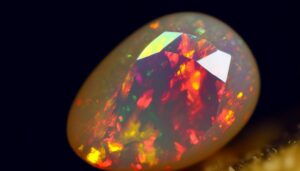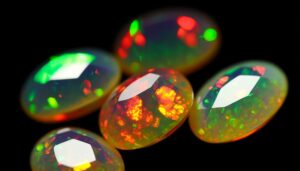How to Prevent Your Opal from Losing Its Fire
Yes, an opal can lose its fire. Changes in water content, caused by humidity fluctuations, can alter the stability of silica spheres, impacting light diffraction and color vibrancy.
Exposure to direct sunlight, harsh chemicals, or physical impacts can also create surface damage, leading to a loss of the stone's characteristic play-of-color. Even improper storage in dry conditions can lead to cracks, further dulling the opal.
To better preserve opal brilliance, maintain stable environmental conditions and handle with care. Understanding these variables is essential for maintaining the beauty and integrity of your opal.
Discover more about protecting your opal here.
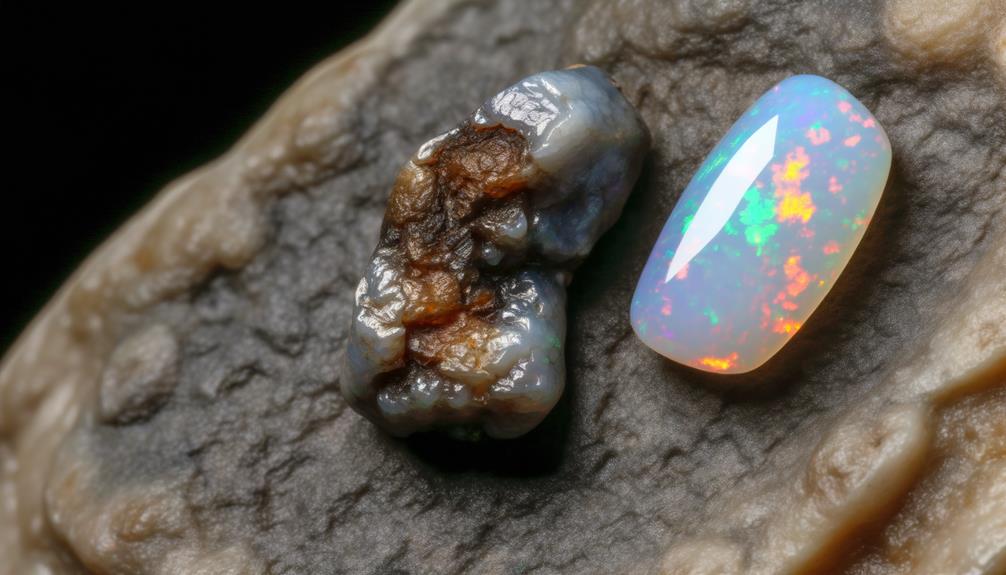
Key Takeaways
- Exposure to direct sunlight can cause opals to fade and lose their fire.
- Rapid temperature fluctuations can induce microfractures that disrupt light diffraction, diminishing fire.
- High or low humidity levels can alter the internal structure, affecting an opal's fire.
- Physical impacts such as dropping or scratching can create fractures, reducing play-of-color.
- Improper storage in dry conditions can lead to dehydration and cracking, diminishing fire.
Understanding Opal Composition
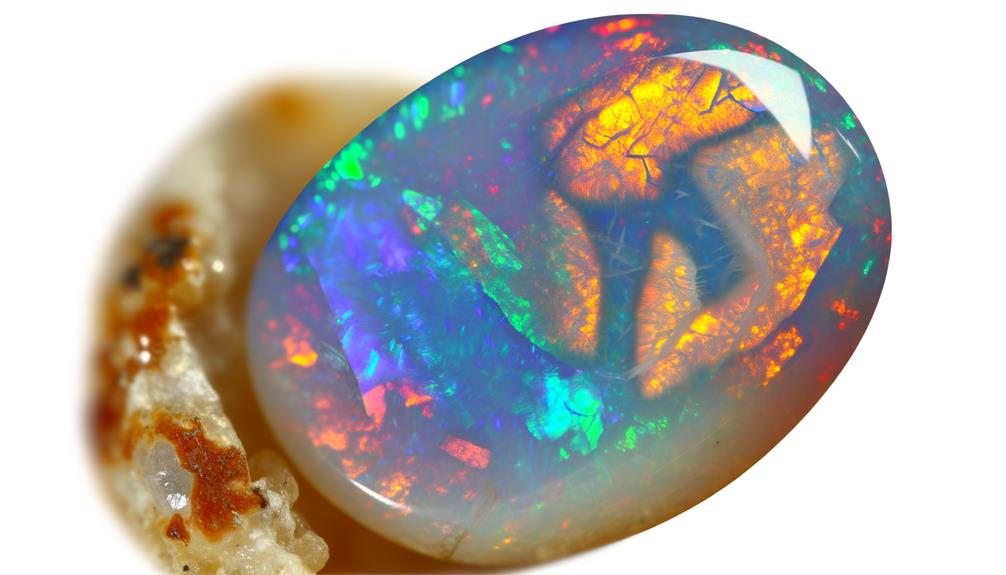
To understand why an opal might lose its fire, you first need to grasp its complex composition, primarily made up of amorphous silica spheres. These tiny spheres, ranging from 150 to 300 nanometers in diameter, arrange themselves in a tightly packed, orderly lattice.
This structure is essential because it creates the opal's unique internal diffraction grating, responsible for its stunning visual effects. Water content, typically between 3% and 21%, also plays a vital role in maintaining the opal's integrity. Any significant change in this water content can affect the stability of the silica spheres, potentially causing cracks or a loss of transparency.
Understanding these factors is key to recognizing how an opal might lose its mesmerizing fire.
The Science of Play-of-Color
You'll observe that the play-of-color in opals arises from light interference within microscopic silica spheres. These spheres are arranged in a precise lattice structure, causing different wavelengths of light to diffract and produce vibrant colors.
Variations in the size and arrangement of these spheres lead to the diverse color patterns seen in opals.
Light Interference Phenomenon
When light enters an opal, it interacts with the silica spheres inside, creating the enchanting play-of-color through a process known as light interference. This phenomenon occurs because the different wavelengths of light scatter as they pass through the microscopic structure. The result is a spectrum of colors that shift and dance as the light source or viewing angle changes.
| Color | Wavelength (nm) | Emotion Evoked |
|---|---|---|
| Red | 620-750 | Passion, Energy |
| Orange | 590-620 | Enthusiasm, Warmth |
| Green | 495-570 | Calm, Balance |
| Blue | 450-495 | Serenity, Depth |
You'll notice how each color's wavelength contributes to the opal's dynamic display, making it a mesmerizing gem. Light interference is the key to this natural wonder.
Microscopic Silica Spheres
At the heart of an opal's dazzling play-of-color are microscopic silica spheres, which are meticulously arranged in a grid-like pattern. These spheres measure between 150 to 300 nanometers in diameter and create a diffraction grating for light.
When light enters the opal, it interacts with these silica spheres, causing diffraction and interference. This results in the separation of light into its spectral colors. The precise arrangement and uniformity of these spheres are essential; any irregularities disrupt the play-of-color.
You can think of it as a natural, microscopic prism embedded in the gemstone. The angles and distances between the spheres dictate the specific colors you see, making each opal's display unique.
Understanding this structure explains why opals can lose their fire.
Color Variation Causes
The play-of-color in opals results from the interaction of light with the precise arrangement of silica orbs. This interaction can vary due to factors like orb size and consistency. When light enters the opal, it's diffracted by these silica orbs, creating a spectrum of colors. Smaller orbs produce blues and violets, while larger orbs generate reds and oranges.
The consistency of these orbs ensures consistent diffraction, leading to vibrant play-of-color. If the orbs lack consistency, the diffraction becomes irregular, causing muted or inconsistent colors. Additionally, the density of the orbs impacts the intensity of the play-of-color.
Changes in environmental conditions, such as humidity and temperature, can alter the silica arrangement, affecting the opal's fire and overall appearance.
Types of Opals
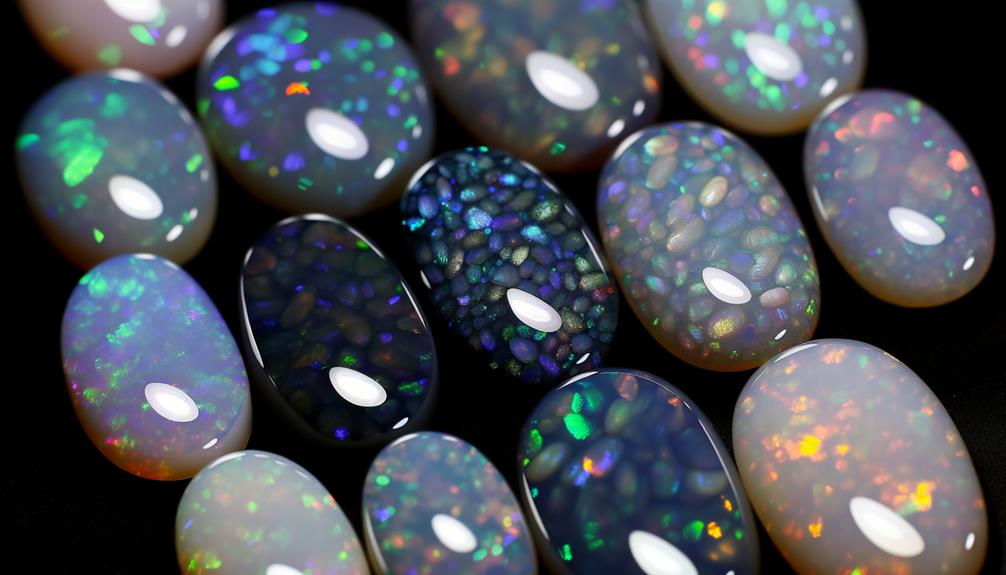
When examining opals, you'll encounter three primary categories: precious opals, common opals, and fire opals.
Precious opals are renowned for their play-of-color, a phenomenon resulting from their unique internal structure.
Common opals lack this play-of-color, while fire opals are noted for their vibrant orange to red hues.
Precious Opals Explained
You'll find that precious opals, renowned for their mesmerizing play of color, come in various types, each with unique characteristics and formation processes. These opals are formed from silica deposits in sedimentary environments, and their play of color is due to the diffraction of light through silica spheres. Understanding the types of precious opals can enrich your appreciation for this stunning gemstone.
| Type of Opal | Characteristics | Formation Process |
|---|---|---|
| Black Opal | Dark body tone, vibrant colors | Formed in sedimentary rock |
| White Opal | Light body tone, pastel colors | Found in sandstone or claystone |
| Boulder Opal | Mixed with ironstone | Developed in cracks of ironstone |
| Crystal Opal | Transparent to translucent | Silica gel deposition, clear body tone |
Common Opals Characteristics
In contrast to their precious counterparts, common opals lack the play of color but exhibit a wide range of hues and are often found in volcanic rocks and areas with high geothermal activity.
As you explore into their characteristics, you'll notice their unique variations and natural beauty. Common opals, also known as potch, are primarily composed of hydrated silica. They can be translucent, opaque, or almost transparent.
Here are four notable types of common opals:
- Milk Opal: White or light-colored, often with a milky appearance.
- Honey Opal: Yellow to brown shades, resembling honey.
- Wood Opal: Fossilized wood replaced by opal.
- Moss Opal: Contains dendritic inclusions resembling moss or plant life.
Fire Opals Overview
Fire opals, known for their vivid orange to red hues, are unique among opals due to their fiery coloration and lack of the typical play of color found in precious opals. These opals consist mainly of hydrated silica and display their vibrant colors because of the presence of iron oxide impurities.
You'll find them mostly in volcanic regions, such as those in Mexico, where they form within rhyolitic lava flows. Unlike other opals, fire opals can sometimes exhibit transparency, adding to their allure.
When examining fire opals, consider their clarity, color uniformity, and saturation. These factors influence the stone's overall value and visual impact. Proper care is essential to maintain their beauty, as they're slightly softer than other gemstones.
Common Causes of Dullness
Several factors can cause an opal to lose its vibrant fire, often stemming from environmental conditions and handling practices. Issues you might encounter include:
- Exposure to direct sunlight: Ultraviolet rays can break down the chemical bonds within the opal, causing color fading.
- Contact with harsh chemicals: Cleaning agents or cosmetics can cause surface damage, leading to a dull appearance.
- Physical impacts: Dropping or knocking the opal can create micro-fractures, disrupting light diffraction and diminishing its fire.
- Improper storage: Storing opals in extremely dry conditions can cause them to lose moisture, leading to internal cracks and loss of brilliance.
Understanding these factors helps in maintaining your opal's dazzling fire and ensuring its longevity.
Impact of Humidity
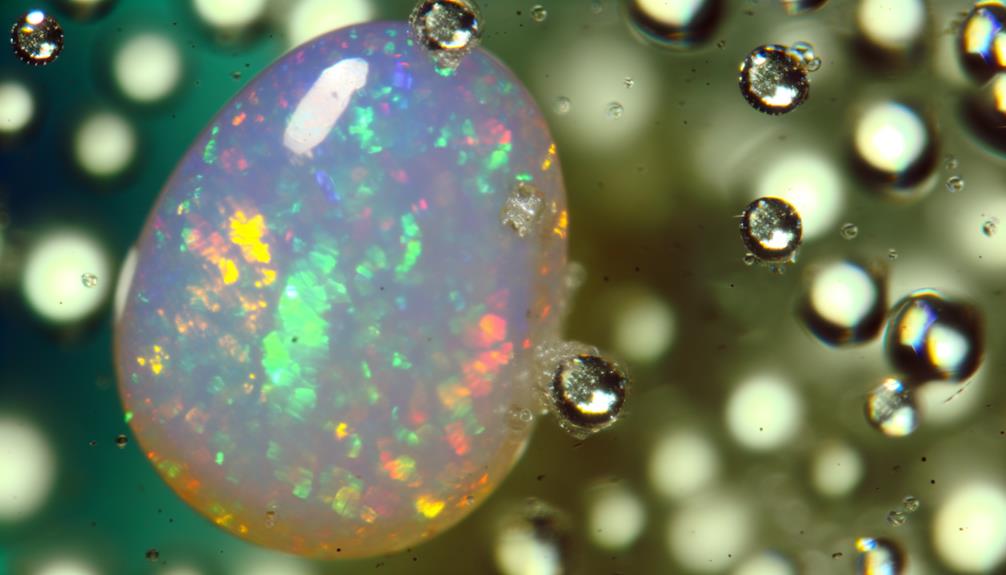
You should know that humidity greatly affects opals, as these gems contain water within their silica structure. High humidity can cause hydrophane opals to absorb moisture, altering their appearance, while low humidity risks dehydration and potential cracking.
Monitoring humidity levels is important to maintain an opal's vibrant fire and structural integrity.
Moisture's Role in Opals
Humidity plays an essential role in the stability and appearance of opals, as fluctuations in moisture levels can lead to significant changes in their internal structure. When an opal absorbs or loses water, its silica structure can either expand or contract, affecting its visual properties.
Here's how moisture impacts opals:
- Water Content Variability: Opals contain 3-21% water, making them sensitive to environmental humidity.
- Internal Stress: Changes in moisture levels can create stress within the opal, altering its structural integrity.
- Color Play: Excessive moisture can disrupt the diffraction of light, impacting the opal's 'fire'.
- Texture Changes: Variations in humidity can cause surface alterations, affecting the opal's smoothness.
Understanding these factors helps you maintain the opal's beauty effectively.
Humidity-Induced Cracking Risk
Fluctuations in environmental humidity can induce internal stress within opals, increasing the risk of cracking. When humidity levels rise, opals absorb water, causing them to expand. Conversely, when humidity drops, they release water, leading to contraction. These expansion and contraction cycles generate stress within the opal's structure.
Over time, this stress can manifest as cracks, compromising the gem's integrity and diminishing its aesthetic value. You should store opals in a stable, humidity-controlled environment to mitigate these risks. Avoid exposing them to rapid changes in humidity, such as moving them from a humid bathroom to a dry, air-conditioned room.
Consistent conditions help maintain the opal's structural integrity and preserve its enchanting fire.
Hydrophane Opals and Water
Hydrophane opals, known for their unique ability to absorb and release water, exhibit a pronounced sensitivity to ambient humidity levels. This sensitivity impacts their appearance and stability.
When exposed to varying humidity, you'll notice several changes:
- Color Shift: Increased moisture can make the opal appear more transparent, altering its play-of-color.
- Weight Variation: Absorbing water increases the opal's weight, which can affect its overall structure.
- Surface Texture: Changes in humidity can cause the opal's surface to become tacky or slick.
- Risk of Cracking: Rapid humidity changes can induce stress, potentially leading to cracks.
Temperature Extremes
When exposed to extreme temperatures, opals can suffer structural damage that may cause them to lose their characteristic fire. Rapid temperature fluctuations can induce thermal stress, leading to microfractures within the opal's silica structure. These microfractures disrupt the diffraction of light, diminishing the stone's play-of-color.
High temperatures can also cause dehydration, resulting in a brittle and dull surface. Conversely, extreme cold can contract the opal's structure, further exacerbating existing fractures. To preserve an opal's fire, maintain a stable ambient environment, avoiding sudden changes in temperature.
Employ protective measures like insulating storage and avoiding direct sunlight or heating sources. By understanding these vulnerabilities, you can secure your opal retains its vibrant play-of-color and structural integrity over time.
Physical Damage
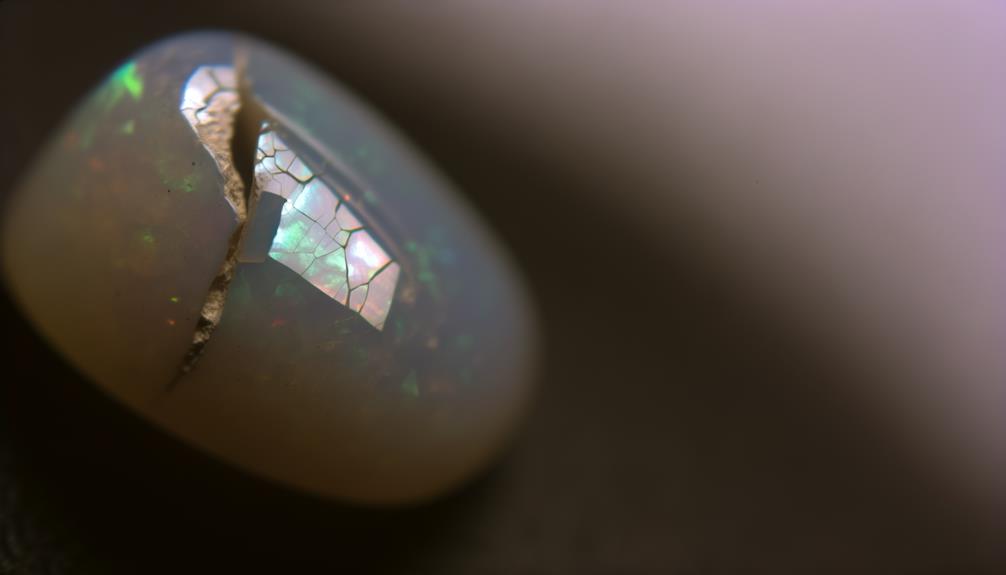
Physical damage can impair an opal's fire, as even minor abrasions or impacts can disrupt the delicate arrangement of silica spheres responsible for its iridescence. When you handle opals, be mindful of their vulnerability to physical stress.
Key points to keep in mind include:
- Surface Scratches: These can scatter light differently, diminishing the opal's vibrant play-of-color.
- Chips and Cracks: Impact can cause structural fractures, which may permanently alter the internal reflection patterns.
- Pressure: Excessive pressure can compress the silica spheres, leading to a loss of fire.
- Handling: Frequent touching can wear down the surface over time, affecting its optical properties.
Chemical Exposure
Chemical exposure can greatly compromise an opal's fire by altering its surface composition and internal structure. When you expose an opal to harsh chemicals, such as household cleaners, acids, or even prolonged contact with skin oils, you risk damaging the delicate arrangement of silica spheres that produce its characteristic play-of-color.
These chemicals can infiltrate the microscopic pores within the opal, leading to desiccation and micro-fracturing. Over time, this results in a loss of luster and the dimming of its vibrant colors. Moreover, prolonged chemical contact can cause surface etching, creating a dull, matte finish instead of the desired iridescent sheen.
Understanding these risks helps you preserve the opal's natural beauty and prevent irreversible damage.
Proper Cleaning Techniques
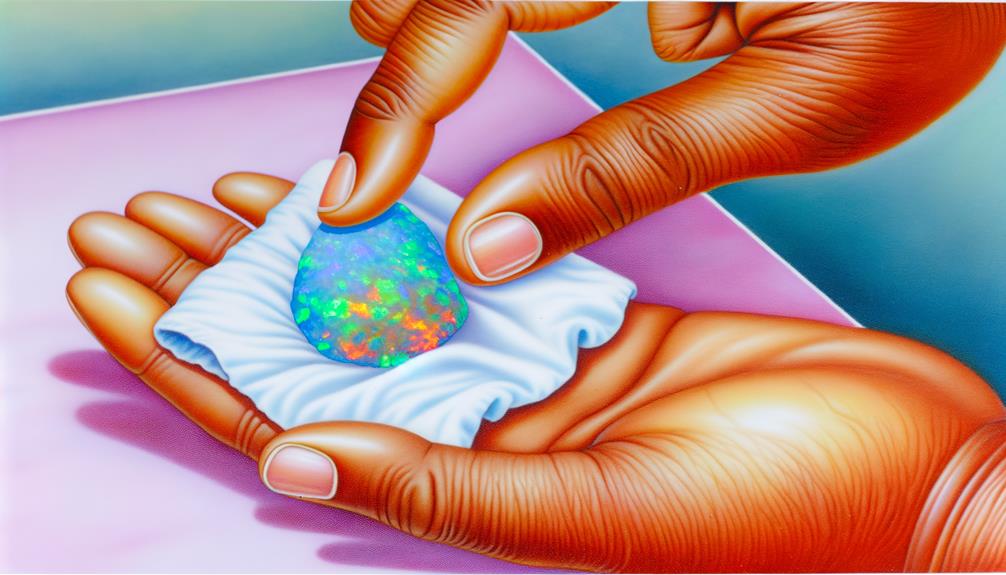
To effectively clean an opal and maintain its fire, use only gentle, non-abrasive solutions and avoid soaking it in water for extended periods. Focus on preserving the delicate silica structure and vibrant play-of-color. Follow these steps:
- Use a soft, damp cloth: Gently wipe the opal's surface to remove dirt and oils. Make sure the cloth is just damp and not saturated.
- Mild soap solution: Mix a few drops of gentle, pH-neutral soap with water. Apply this with a soft cloth, then rinse promptly.
- Avoid chemicals: Keep the opal away from strong cleaners and solvents that can harm its unique structure.
- Pat dry carefully: Use a clean, soft cloth to gently pat the opal dry, preventing water spots and potential water damage.
These techniques help maintain your opal's stunning appearance.
Safe Storage Practices
After ensuring your opal is clean, store it in a cool, dry place away from direct sunlight and extreme temperatures to preserve its fire and structural integrity.
High temperatures can cause dehydration, leading to cracks and loss of iridescence. Use a soft, lined jewelry box to minimize exposure to moisture and physical stress. Avoid plastic bags, as they can trap humidity, exacerbating potential damage. Additionally, silica gel packets can help maintain a stable environment by absorbing excess moisture.
If you have multiple opals, store them separately to prevent scratching or abrasion. By following these storage practices, you'll notably reduce the risk of your opal losing its distinctive play-of-color and structural soundness.
Regular Maintenance Tips

Regular maintenance is vital for maintaining your opal's fire and structural integrity intact. To safeguard your opal remains vibrant, follow these scientifically-backed tips:
- Clean Gently: Use a soft cloth and tepid water to remove dust and grime. Steer clear of harsh chemicals that can deteriorate the opal's surface.
- Monitor Humidity: Opals contain water and can crack if they dry out. Store them in environments with consistent humidity levels, preferably between 45-55%.
- Inspect Regularly: Periodically check for any indications of cracking or dullness. Early identification of issues can prevent further damage.
- Avoid Extreme Temperatures: Abrupt temperature changes can cause thermal shock, leading to fractures. Keep your opal away from heat sources and direct sunlight.
Professional Restoration
Engage a certified gem expert to rejuvenate your opal's fire and brilliance when regular maintenance isn't sufficient. Gemologists utilize specialized tools and techniques to delicately rehydrate desiccated opals and polish their surfaces.
They might utilize a controlled environment to mimic the opal's natural conditions, preventing further dehydration. Additionally, they can fill tiny fractures with optically compatible resins, enhancing the stone's stability and visual charm.
Their scientific analysis guarantees that each treatment is customized to the specific characteristics of your opal, taking into account factors like type, origin, and current state. Detailed observations during the restoration process allow for adjustments, ensuring excellent results.
Trusting a professional ensures your opal regains its enchanting play-of-color, preserving its value and beauty for years to come.
Choosing Quality Opals
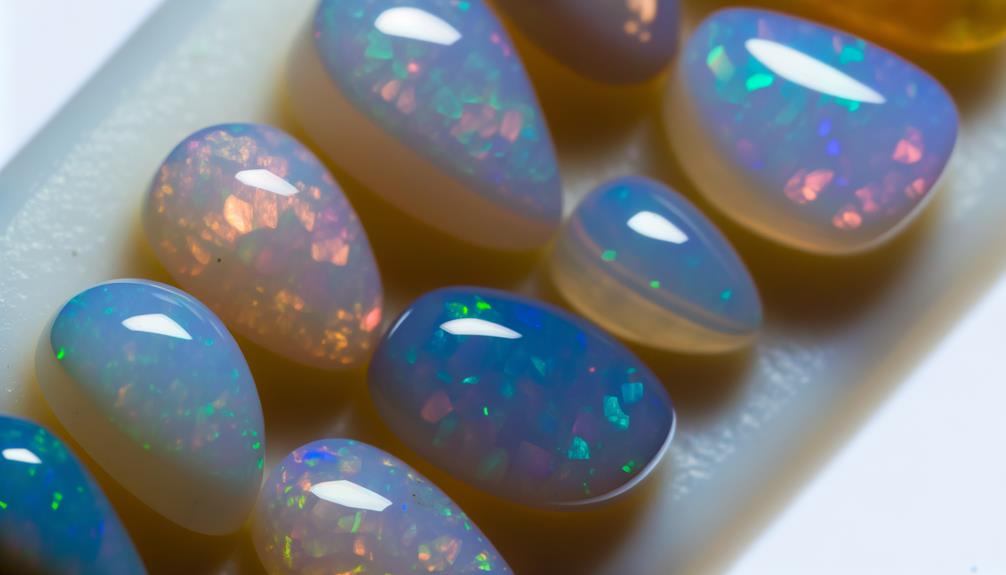
When choosing quality opals, prioritize factors like color play, clarity, and cut to guarantee you acquire a gemstone with enduring brilliance. Opals exhibit a phenomenon known as 'play-of-color,' which involves the diffraction of light to produce a spectrum of colors. Evaluate the stone's clarity to confirm minimal inclusions or cloudiness that might obscure its vibrancy. The cut of the opal should maximize its optical properties, enhancing its natural luminescence.
Consider the following:
- Color Play: Look for opals with broad, vivid flashes of multiple colors.
- Clarity: Choose stones with few or no inclusions.
- Cut: Opt for cuts that highlight the opal's color play.
- Durability: Select opals with stable matrix structures to prevent cracking.
These criteria guarantee you select a high-quality opal.
Conclusion
In your quest to preserve an opal's fire, think of it as guarding a precious flame. Each opal, like a delicate lantern, relies on your care to keep its vibrant dance alive.
By understanding its composition, managing moisture levels, and practicing safe storage, you guarantee that the light within remains undimmed.
Regular upkeep and expert care act as the wick and oil, sustaining the opal's brilliance. Choose wisely, and your opal will continue to sparkle, a sign of your vigilance.

